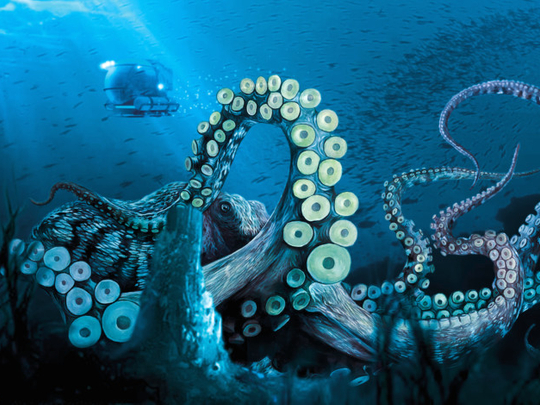
When I first learned to dive, every coral reef or kelp forest looked like something out of a science fiction story.
Over the years, I’ve spent more than 3,000 hours underwater, even co-designing a submersible and piloting it to remote, otherworldly destinations.
What I’ve witnessed and learned has helped shape me, as an explorer and a resident of our planet, as well as a filmmaker.
When I travelled 12,000 feet underwater to the Titanic, it profoundly reinforced my reverence for the ocean and the importance of bringing powerful stories back to the surface.
The ocean has been a source of inspiration for millennia. Our ancestors looked to the watery horizon, expanding the boundaries of what we know about ourselves and the globe.
Where their knowledge ended, they filled the gaps with dragons and other myths. But instead of turning away in fear, they sailed beyond the edges of our maps, returning with stories that inspired generations of future explorers.
Today, with seemingly every corner of the planet laid bare, we only have to look beneath the surface of the ocean to encounter another world right here on Earth that is an integral part of our own existence, yet that we barely know.
It’s a realm that helps make our planet liveable, and one that we are in danger of changing before we’ve had a chance to understand it.
Just 650 feet down, at the edge of the sunlight’s reach, is a region known as the twilight zone, one of the last and most important remaining frontiers on Earth.
This vast, largely unexplored layer is home to some of the most fantastic life on Earth.
The bristlemouth — a tiny fish with a gaping, “Alien”-like jaw and bioluminescent patches on its body — is thought to be the most numerous vertebrate on the planet, possibly numbering in the hundreds of trillions or quadrillions, meaning that there may be more of them than there are stars in our galaxy.
Animal migration
The twilight zone is also home to the largest animal migration on Earth, as its inhabitants swim up at night to feed in surface waters and down in the daytime to avoid predators.
Theirs is a motion that sweeps across the planet every day, and that may actually help mix the upper ocean, which is critical to sustaining life beneath the waves.
And while there’s tantalising evidence to suggest that there may be more fish biomass in the twilight zone than in all the rest of the ocean combined, no one can say for sure how much — or even what — lives there because we simply don’t know enough about it.
Nevertheless, the sheer mass of life in the twilight zone has, predictably, begun to attract the attention of commercial fishing fleets.
Those enterprises have focused on extracting resources from surface waters, but plans are in the works to begin tapping the twilight zone’s seemingly endless supply of protein to feed aquaculture operations and to manufacture “nutraceuticals” like krill oil.
Mistake
Almost every other major fishery on the planet started in this way, building on the assumption that the ocean’s resources were limitless.
That is almost always a mistake.
We need only study the lessons of the Northwest Atlantic cod fishery to see that not only can we overfish a single species, but that doing so can devastate a whole marine ecosystem. And this time, it’s not just a fishery that we stand to lose.
Exploitation of the twilight zone with little knowledge of what’s there and how it functions as a whole may disrupt one of the most reliable natural systems we have to counteract widespread climate change.
Since the dawn of the Industrial Age, the ocean has absorbed nearly one-third of the excess carbon dioxide humans have poured into the atmosphere, largely thanks to tiny, plant-like organisms known as phytoplankton.
Those organisms, in turn, become food for many twilight zone residents and migrants that create a cascade of “marine snow” that carries carbon dioxide into the deep ocean, where it can remain safely removed from the atmosphere, sometimes for thousands of years or more.
Disrupt that ecosystem, and far more carbon dioxide will remain in the atmosphere, warming the planet.
Risks
There are other risks, too: Harvesting even the most abundant organisms without understanding their role could also indelibly alter the complex marine food web.
In the process, we risk disrupting surface fisheries and threatening large animals such as whales and sharks — charismatic symbols of a wild, open, and healthy ocean that we turn to again and again for inspiration.
But where there are threats and peril, there are also openings for hope. I look at the ocean and see a near-limitless opportunity for us to explore our planet more deeply than ever before.
As we collect scientific data, we will tell stories that fill gaps in our knowledge, feeding our collective imagination, motivating ourselves and future generations to better our world in the process.
To do this, scientists and communicators will have to partner in a sweeping exploration of the twilight zone. New knowledge and understanding, communicated widely, will foster greater respect for the ocean and everything it does to make our planet habitable.
This will be a voyage of discovery in the tradition of human exploration through the ages — one that just might encourage us to protect the ocean that protects us, before we change it forever.
— Washington Post
James Cameron is a filmmaker, explorer and an adviser to both the Ocean Twilight Zone Audacious Project at the Woods Hole Oceanographic Institution and to the OceanX media initiative.









